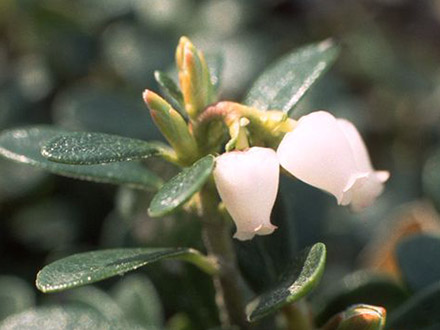Botanical name
Arctostaphylos uva-ursi (L.) Spreng.
Family
Ericaceae
Common name
Bearberry, Uva Ursi, Red bearberry, Common bearberry, Kinnikinnick
Information about the plant
Bearberry grows at higher altitudes throughout the Northern Hemisphere. Thus, it can be found in Europe from the Iberian Peninsula over the whole of Central Europe to Scandinavia. In the East, it is widespread up to Siberia, the Altai, and the Himalayas. In southern regions, bearberry grows in mountainous regions, often above the tree line, while in northern regions it grows deep in the valleys. Bearberry is a procumbent dwarf shrub, often forming dense mats, with leathery, shiny, small deciduous leaves. The small, white to reddish, bell-shaped blossoms stand in terminal, pendant racemes, from which, in late summer, vermilion, baccate fruits with hard seeds develop.
In Linnaeus’ time, the plant was still called Arbutus uva-ursi. Following a renaming, the genus name was formed as a loan translation of the species epithet uva-ursi. The Latin ‘uva’ (= grape) then became the Greek ‘staphyle’, and the Latin ‘ursus’ (= bear) became the Greek ‘arktos’. The German name of the plant (Bärentraube) is therefore a translation of the botanical name. The reference to the bear comes from the occurrence of this species in circumpolar regions under the constellation of Ursa Major (lat. ‘ursa maior’; gr. ‘arktos’). The “grape” refers to the red, berry-like fruits that hang like grapes on a vine.
Medicinally used parts of plants (herbal drug)
The dried leaves (bearberry leaves – Uvae ursi folium) are used.
The commercially available drug comes from wild harvest in Spain and Italy.
Constituents of the herbal drug
Bearberry leaves contain arbutin (hydroquinone glucoside) and other phenolic glycosides, tannins, and flavonoids.
Quality of the drug
The quality of bearberry leaves (Uvae ursi folium) is specified in the European Pharmacopoeia (Ph. Eur.).
Medical applications
Recognised medical use
The HMPC has classified bearberry leaves as a traditional herbal medicinal product (see “Traditional Use”).
ESCOP: uncomplicated infections of the lower urinary tract such as cystitis, when antibiotic treatment is not considered essential.
Traditional use
Bearberry leaves have been classified by the HMPC as a traditional herbal medicinal product (§ 39a AMG). Based on many years of experience, bearberry leaves can be used to treat symptoms of mild recurrent lower urinary tract infections, such as burning sensation during urination and/or frequent urination in women, after serious conditions have been excluded by a medical doctor.
Herbal drug preparations in finished dosage forms
- Cut bearberry leaves as tea.
- Dry extracts standardized to hydroquinone derivatives (arbutin) in tablets.
- Liquid extracts standardized to hydroquinone derivatives (arbutin) in liquids.
Dosage
Finished dosage form: see patient information leaflet.
Tea infusion: one warm cup of bearberry tea up to 4 times a day; daily dose 6 to 12 g drug or 400 to 840 mg hydroquinone derivatives, calculated as arbutin.
A combination with other drugs such as restharrow root, orthosiphon leaves, or birch leaves (bladder and kidney tea, urological tea) is also useful.
Preparation of a tea
Pour 150 ml of hot water over 2.5 g of finely chopped or preferably coarsely powdered bearberry leaves and strain after 10 to 15 min. To keep the tannin content as low as possible, it is advisable to prepare a cold-water maceration. For this, leave the drug in cold water for 6 to 12 hours, then strain the drug and heat the tea.
Notes
The safety of bearberry leaves during pregnancy and lactation has not yet been established. Due to insufficient data, the use of bearberry leaves during pregnancy and lactation is not recommended.
The use in children and adolescents under 18 years of age is not recommended due to concerns requiring medical advice. The use in men is not recommended due to concerns requiring medical supervision.
If complaints or symptoms such as fever, dysuria, spasms, or blood in urine occur during the use of the medicinal product, a doctor or a qualified health care practitioner should be consulted, as well as if the symptoms persist for more than 4 days. The use in cases of kidney disorders is contraindicated. Bearberry leaves should not be taken for more than one week. In case of inflammation of the urinary tract, plenty of water should be consumed.
Uvae ursi folium may cause a greenish-brown coloration of the urine.
Side effects
In stomach-sensitive people, taking bearberry leaves can cause gastric disorders due to the tannin contents.
Interactions
None known
References
Herbal drug monographs
HMPC (2018), ESCOP (2012), Commission E (1994), WHO vol. 2
Further literature
Commentary on the European Pharmacopoeia (Bearberry leaves, Nr. 1054)


